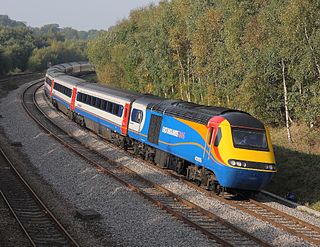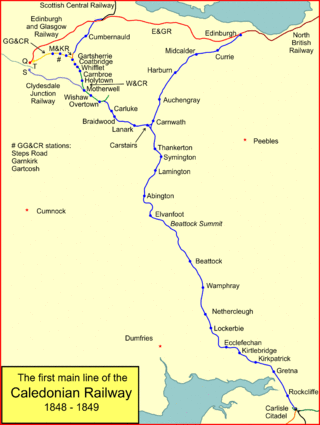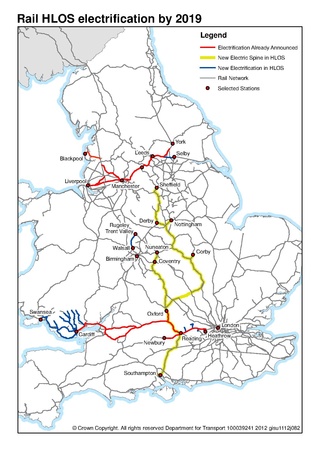
Network Rail Limited is the owner and infrastructure manager of most of the railway network in Great Britain. Network Rail is a non-departmental public body of the Department for Transport with no shareholders, which reinvests its income in the railways.

The West Coast Main Line (WCML) is one of the most important railway corridors in the United Kingdom, connecting the major cities of London and Glasgow with branches to Birmingham, Liverpool, Manchester and Edinburgh. It is one of the busiest mixed-traffic railway routes in Europe, carrying a mixture of intercity rail, regional rail, commuter rail and rail freight traffic. The core route of the WCML runs from London to Glasgow for 399 miles (642 km) and was opened from 1837 to 1869. With additional lines deviating to Northampton, Birmingham, Manchester, Liverpool and Edinburgh, this totals a route mileage of 700 miles (1,127 km). The Glasgow–Edinburgh via Carstairs line connects the WCML to Edinburgh. However, the main London–Edinburgh route is the East Coast Main Line. Several sections of the WCML form part of the suburban railway systems in London, Coventry, Birmingham, Liverpool, Manchester and Glasgow, with many more smaller commuter stations, as well as providing links to more rural towns.

The Midland Main Line (MML) is a major railway line from London to Sheffield in Yorkshire via the East Midlands. It comprises the lines from London's St Pancras station via Leicester, Derby/Nottingham and Chesterfield.

Watford Junction is a railway station that serves Watford, Hertfordshire. The station is on the West Coast Main Line (WCML), 17 miles 34 chains from London Euston and the Abbey Line, a branch line to St Albans. Journeys to London take between 16 and 52 minutes depending on the service used: shorter times on fast non-stop trains and slower on the stopping Watford DC line services. Trains also run to Clapham Junction and East Croydon via the West London Line. The station is a major hub for local bus services and the connecting station for buses to Warner Bros. Studio Tour London – The Making of Harry Potter. The station is located north of a viaduct over the Colne valley and immediately south of Watford Tunnel.

The North Wales Main Line, also known as the North Wales Coast Line, is a major railway line in the north of Wales and Cheshire, England, running from Crewe on the West Coast Main Line to Holyhead on the Isle of Anglesey. The line has 19 stations, with all except two, Chester and Crewe, being in Wales.

Kilburn High Road railway station is a London Overground station on the London Euston to Watford DC Line near the south end of the Kilburn High Road, London NW6 in the London Borough of Camden.

Bletchleyrailway station serves the southern parts of Milton Keynes, England, and the north-eastern parts of Aylesbury Vale. It is 47 miles (76 km) northwest of Euston, about 32 miles (51 km) east of Oxford and 17 miles (27 km) west of Bedford, and is one of the seven railway stations serving the Milton Keynes urban area.

Caledonian Sleeper is the collective name for overnight sleeper train services between London and Scotland, in the United Kingdom. It is one of only two currently operating sleeper services on the railway in the United Kingdom, the other being the Night Riviera which runs between London and Penzance.

Motherwell railway station is a railway station serves the town of Motherwell, North Lanarkshire, Scotland. It lies on the West Coast Main Line (WCML), and is served also by Argyle Line trains of the Glasgow suburban railway network. It is the penultimate stop on the northbound WCML before Glasgow. There are four platforms of various length in use at Motherwell. The station is located next to the town's main shopping arcade, Motherwell Shopping Centre. Ticket Gates are in operation as of 2023

Carstairs railway station serves the village of Carstairs in South Lanarkshire, Scotland and is a major junction station on the West Coast Main Line (WCML), situated close to the point at which the lines from London Euston and Edinburgh to Glasgow Central merge. Constructed originally by the Caledonian Railway, the station is operated today by ScotRail and is also served by one TransPennine Express trains service per day between Manchester Airport and Glasgow Central. All other services by TransPennine Express and services operated by Avanti West Coast, Caledonian Sleeper, CrossCountry and London North Eastern Railway pass the station, but do not stop.

Railway electrification in Great Britain began in the late 19th century. A range of voltages has been used, employing both overhead lines and conductor rails. The two most common systems are 25 kV AC using overhead lines, and the 750 V DC third rail system used in Southeast England and on Merseyrail. As of October 2023, 6,065 kilometres (3,769 mi) (38%) of the British rail network was electrified.
Weaver Junction is a railway junction connecting the West Coast Main Line (WCML) with the Weaver Junction–Liverpool line, opening on 1 April 1869. Trains bound for Liverpool from London diverge from the WCML at this junction. Weaver Junction is the oldest flying junction in Britain, and also the world.

The period from 1995 covers the history of rail transport in Great Britain following the privatisation of British Rail. During this period, passenger volumes have grown rapidly, safety has improved, and subsidies per journey have fallen. However, there is debate as to whether this is due to privatisation or to better government regulation. During this period, High Speed 1, the West Coast Main Line upgrade and Crossrail were completed and more construction projects are currently under way. The period also saw the demise of privately-owned Railtrack and its replacement with government-owned Network Rail.
Colwich Junction is a rail junction near the village of Little Haywood, in the county of Staffordshire, England. It is the junction between two routes of the West Coast Main Line: the Trent Valley line and the Stone to Colwich cutoff line. The junction was the site of the 1986 Colwich rail crash.

The Caledonian Railway main line in Scotland connected Glasgow and Edinburgh with Carlisle, via Carstairs and Beattock.

The Midland Main Line upgrade is an ongoing upgrade to the Midland Main Line (MML), a major railway line in the United Kingdom. There have been a number of proposals to electrify the line over many years but the 2012 proposal and announcement by the UK government was that it would include electrification of the railway line between Bedford, Wellingborough, Corby, Leicester, Derby, Nottingham and Sheffield. The routes between Nottingham and Sheffield and the Erewash Valley line were not included at this time, only the line between Derby and Sheffield. The upgrade was part of the HLOS - High Level Output Specification for Control Period 5 published by the UK Government in 2012. This was also part of a rolling programme of railway electrification projects. To enable all the benefits of using electric traction, the line south of Bedford into London St Pancras is also being progressively upgraded including boosting the power supply. Parts of the line have been classed as congested infrastructure hence another reason for the upgrade.
North West England electrification schemes are a series of individual railway lines in North West England that have been, and continue to be electrified and upgraded. It is planned that these schemes will result in a modernised, cleaner, lower carbon and faster railway with improved capacity.
The Felixstowe to Nuneaton railway upgrade in the United Kingdom is a series of upgrades being made to both a key strategic freight route and one that carries passengers on many parts. It is one of only two routes between the busiest container port and the Midlands, the other being via London. The route and the upgrade is sometimes abbreviated to F2N. The railway route includes the Birmingham–Peterborough line for a large part. The line links the Port of Felixstowe in Felixstowe, Suffolk, with the Midlands and crosses the East Coast Main Line, the Midland Main Line and the West Coast Main Line and thus the north and Scotland. From Nuneaton, a number of intermodal terminals may be reached. Much infrastructure in the UK is of Victorian origin and thus needed an upgrade; F2N, being a key route, is no exception.
Railway electrification in Scotland has proceeded in a different fashion than the rest of the UK especially in the 21st Century. There is political commitment to a substantial rolling programme of railway electrification from the Scottish government where transport is devolved. Transport Scotland and others have said "In Scotland, decarbonisation is spelt E-L-E-C-T-R-I-F-Y". All parties in Scotland are vigorously campaigning for electrification. As of January 2022, there are 2776 kilometres of track in Scotland, and 711 kilometres are electrified representing 25.3%. To meet these needs, the plan is to electrify on average 130 single track kilometres (STK) per year until 2035, although there has been some slippage in this target.

















